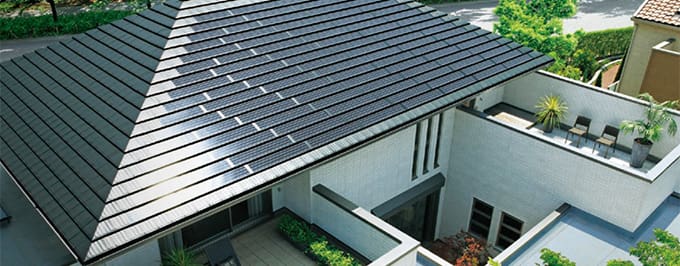
Decarbonized SocietyAction policies ③ Reduce CO2 emissions in business activities of the Sekisui House Group
![]()
![]()
![]()
![]()
![]()
Adopting renewable energy → 50% by 2030, 100% by 2040 (under RE100)
Activity report
We established Sekisui House Owner Denki to purchase post-FIT power from homeowners for use in powering the company's business operations.
In November 2019, we launched Sekisui House Owner Denki, a system by which surplus power from solar power generators is purchased from homeowners and is used to power the business operations of our group.
Electricity companies began purchasing surplus electricity from solar power systems at a fixed price in 2009. Under the feed-in tariff (FIT) system, the power purchase period (10 years) for residential solar power (less than 10 kW) has expired. This system allows our company to satisfy homeowners by purchasing this post-FIT power at the industry's highest rate* of 11 yen/kWh.
In October 2017, the Sekisui House Group joined the Japanese construction industry's first RE100 initiative. We committed to sourcing 50% of the electricity used in our business operations from renewable energy suppliers by 2030, with renewables rising to 100% by 2040. For this reason, the electricity purchased at Sekisui House Owner Denki is used for business operations.
As of March 31, 2020, about 47% of homeowners eligible for post-FIT electricity sales have joined Sekisui House Owner Denki.

- Applicable when no other incidental conditions apply, such as the designation of the power company purchasing the electric power or the requirement that storage batteries be installed
Year-on-year reduction in CO2 emissions from commercial vehicles by 1,160 tonnes (3.8%)
The Sekisui House Group's 12,000 commercial vehicles are equipped with telematics* devices. We encourage safe and eco-friendly driving practices by promoting routine improvement activities at our business sites and through company-wide, long-term improvement initiatives that utilize driving data such as instances of rapid acceleration or braking. Our group held safe driving training sessions more than 400 times during the year, resulting in a year-on-year reduction in CO2 emissions of 1,160 tonnes (representing a decrease of 3.8%) thanks to ongoing practices such as distribution of safe driving notebooks, DVD teaching materials, and sticker production.
Since the introduction of telematics devices for vehicles in 2011, our efforts have earned high praise. Notably, we received the Minister of the Environment's FY2018 Commendation for Global Warming Prevention Activity (Implementation of Countermeasures Category).

- Telematics is a system that provides information on vehicle operation, such as usage and fuel consumption, as well as dangerous driving, such as sudden acceleration or deceleration, using devices fitted in the vehicles and communication terminals.
Sustainability Report 2020 TOP
Contributing to Health, Longevity and Wealth
Pursuing Customer Satisfaction through Our Value Chain TOP
Action policies ② Meticulous supply chain management for material procurement
Action policies ③ Enhancing production and distribution quality and improving operational efficiency
Action policies ④ Strengthening our workmanship and maximizing our construction capabilities
Basic concept & Action policies | Promoting Diversity
Basic concept & Action policies | Workstyle Reforms
Basic concept & Action policies | Human Resource Development
Independent Third-Party Assurance Report



